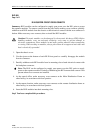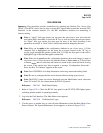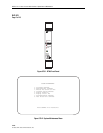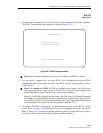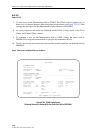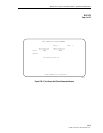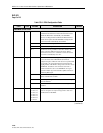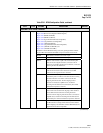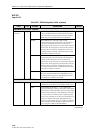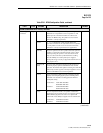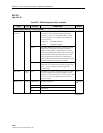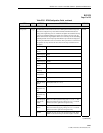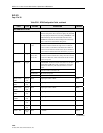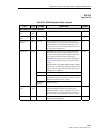
ADCP-61-471 • Issue 4 • June 2000 • Section 2: Operation and Maintenance
2-217
© 2000, ADC Telecommunications, Inc.
DLP-570
Page 7 of 18
Table 570-1. RTAU Configuration Fields, continued
FIELD TYPE OPTIONS DESCRIPTION DEFAULT
EQUIPMENT SETUP FIELDS, continued
Mode Toggle OVERVIEW: Valid access modes and the resulting configurations are shown in
Figure 570-6 (RTAU Test Configuration Block Diagram),
Figure 570-7 (MONF and MONE),
Figure 570-8 (SPLTB and SPLTA),
Figure 570-9 (Typical Round-Robin Test Configuration),
Figure 570-10 (Typical End Test Configuration),
Figure 570-11 (SPLTF and SPLTE),
Figure 570-12 (Typical Point-to-Point Test Configuration),
Figure 570-13 (SPLTFL and SPLTEL), and
Figure 570-14 (LOOPF and LOOPE).
In addition, when the Mode field change is saved by pressing the Enter or Return
key, the MPU will instruct the DS3 MUX to drop and insert the selected circuit.
DISABLE
MONE Non-intrusive monitor access to the A pair.
MONF Non-intrusive monitor access to the B pair.
SPLTA SPLTA mode indicates a split in the A transmission path
with a TSG (Test Signal Generator) connected in the F
direction, and an SPD (Signal Presence Detector) connected
to the signal from the E direction.
SPLTB SPLTB mode indicates a split in the B transmission path
with a TSG connected in the E direction, and an SPD
connected to the signal from the F direction.
SPLTE SPLTE mode indicates a split in both the A and B
transmission paths. An SPD is connected to the line incoming
from the E direction and a TSG is connected to the line
outgoing to the E direction. The line outgoing in the F
direction is connected to a QRSS source, and the line
incoming from the E direction is terminated by the nominal
characteristic impedance of the line.
SPLTF SPLTF indicates a split in both the A and B transmission paths
with a TSG connected to the line outgoing to the F direction,
and an SPD connected to the line incoming from the F
direction. The line outgoing in the E direction is connected to
a QRSS source, and the line incoming from the E direction is
terminated by the nominal characteristic impedance of the line.
SPLTEL SPLTEL indicates a split in both the A and B paths and connects
an SPD to the line incoming from the E direction and a TSG to
the line outgoing in the E direction similar to SPLTE mode. The
signal in the F direction is looped back.
(continued)




